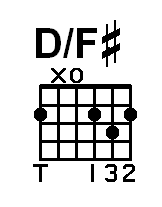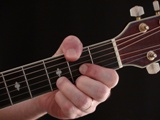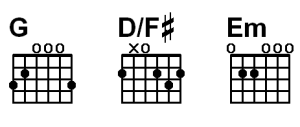Walk Down in G
Lesson Goals:
♦ Determine relative minor of G major
♦ Learn walk down from G to Em
♦ Play a walk down chord progression
In this lesson we will work on a walk down based out of G major.
You should now be able to determine that the relative minor of G major is E minor.
You can do this by starting on a G note on the 3rd fret of the 6th string, and counting down 3 frets, which puts you on the open 6th string (E).
One way to play this walk down is to play the open G chord, then play the passing note, which in this case is the note on the 2nd fret of the 6th string (F#), then play an Em chord. Like this.


Another, and more common, way to play this walk down is to use a new chord with the passing note. This chord is a D/F# (D over F#).


When you see a chord that is notated with a slash (/), that usually means that the chord to be played is the first part (before the slash), and the note on the other side of the slash is the single bass note that should be added to that chord.
In this case, we play an open D chord, and add an F# note. This can be tricky to play using just our fingers, so the easiest way to play this is to use your thumb to play the F# note (on the 2nd fret of the 6th string) by wrapping the thumb up around to top of the neck. You will use the thumb to play the F# note, and, use it to slightly touch the 5th string so it is muted and not heard. Give it a try!
Here is a walk down you will use a lot. You have heard this one a million times!

Now let's play a common chord progression incorporating the G walk down, using the D/F# passing chord.


